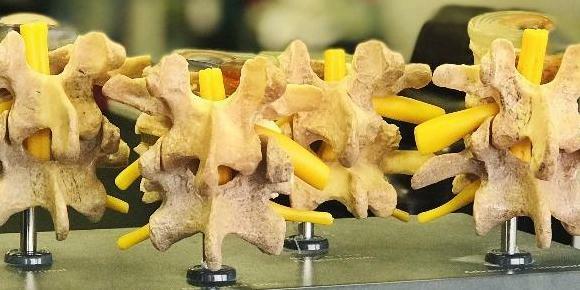
In our last blog post, we defined some of the more commonly heard spinal injury diagnoses. If you missed it, take a moment to make sure you’ve got all the terminology under your belt.
As we look into treatment options for these injuries and diagnoses, we need to first dive into our overall approach to treatment. Regardless of injury or diagnosis, Dr. Bert will assess six areas in order to best devise treatment specific to address your needs. The approach to the evaluation and creation of your treatment plan will be consistent regardless of the condition or injury.
The following six categories working cohesively will lead to optimal recovery and health. This is where your assessment and treatment plan begins:
Kinesiopathology / active and passive range of motion of the affected region
Active and Passive range of motion refers to the ability of individual joints within the body to move freely and fully, thus allowing forces to be distributed appropriately across the surface area of the joint. Decreased range of motion can lead to dysfunction in the joint causing overuse, pain, injury, and inefficient pattern of movement. If Dr. Bert determines a particular segment of the spine or any other joint lacks range of motion, he will work to improve that range of motion. If he determines a particular joint to be hypermobile, we will work with you to strengthen that area in order to stabilize the area. Sometimes, you may have a joint that has a full range of motion, but that range of motion is very stiff and restricted. In that case, we would work to make sure that range of motion is free and unrestricted.
Myopathology / muscular dysfunction that occurs as a result of injury
In the presence of joints that either lack mobility or are hypermobile, the surrounding muscle tissue is often affected. Dr. Bert will assess all surrounding muscle groups to determine how they have been impacted by or have been compensating for the injury. In the presence of an injury, musculoskeletal changes occur as a result of overuse, inflammation, and even postural changes in an effort to protect the affected area.
Neuropathology / overall state of the nervous systems and their functionality
It is through the Central Nervous System (brain and spinal cord) and Peripheral Nervous System (nerves traveling all over your body) that all functions of the human body are controlled and coordinated. If a patient has an unhealthy CNS or PNS they will not be able to express an activity of daily living without potential dysfunction and damage to the human body. An unhealthy CNS and PNS may present as radicular signs and symptoms, nerve pain, muscle weakness, organ dysfunction, and/or dulled senses. It is paramount to life and breath to have a well-functioning nervous system.
Histopathology/swelling, inflammation, and various responses of tissue surrounding an injury
When joints are not in the correct position, or when injury has occurred, the surrounding tissues are also affected. Swelling and inflammation are common in the event of an injury - the tissue will become inflamed in an effort to draw the body’s attention to the area that needs correction. You may also be familiar with the term edema: this is essentially another response the body activates in order to draw attention to an area that has been injured. As we address all areas of the body, Dr. Bert will also observe which soft tissues have been most impacted by the injury. We will then use a variety of modalities to work to decrease the inflammation and swelling in the affected group.
Pathophysiology / secondary damage which can occur due to injury
When one area of the spine or body is injured, multiple areas can be affected. As we’ve mentioned, soft tissue and muscles surrounding the damaged area will be directly impacted, but can also create secondary dysfunction as well. For example, if your right hip is injured, there is a high probability you will experience some level of low back pain. If you have a disc bulge in the cervical spine, you may have musculature in your arms that begin compensating for the damage in your neck and thus cause discomfort. We will address your entire spine, extremities, and all areas potentially impacted by the primary injury.
Somatosensory/coordinated movements - brain and body working together
The somatosensory system is the brain and body’s ability to discover where it is in space and how the body needs to react accordingly. The somatosensory system informs the brain about objects in the world around us through touch and about the position and movement of our bodies (proprioception) through the stimulation of muscles and joints. When there is an injury, namely an injury to the spine (spondylolisthesis, for example) the somatosensory system is oftentimes compromised. Sometimes, the injury itself occurs in part due to a dysfunction in the somatosensory system. This somatosensory system is key in building stability and aids in the prevention of dysfunction and or damage.
-------------
With an approach to treatment that looks into all the areas listed above, you can rest assured your treatment plan will be specific to your needs. When it comes to treating spondylosis, spondylolysis, and spondylolisthesis, there are numerous options available for treatment. Symptoms of these conditions can vary from very mild or non-existent to very severe, so the treatment we offer will match the level of intensity of the injury. As a multi-disciplined clinic, we are able to point you in a variety of directions for treatment. We provide chiropractic treatment, physical therapy, massage therapy, and personal training. We can also utilize a number of treatment modalities including deep soft tissue mobilization, dry needling, Active Release Technique, and Active Isolated Stretching.
It is essential to approach chiropractic care with an open mind and stick with it long enough to understand its potential effects. Adjustments and various modalities can provide temporary relief but are often most effective accompanied by a home exercise program that helps to maintain the integrity of your body. Dr. Bert will carefully monitor your progress, how you are responding to various treatments, and how we need to proceed with care.
We are working together as a multi-disciplined staff, working together with the patient, and working together with other doctors. We are in this together. Together for Health.

8029 Ray Mears Blvd, Suite 300
Knoxville, TN
37919
Phone: 865-337-5574
Monday
7am-12pm & 1pm-6pm
Tuesday
7am-12pm & 1pm-4pm
Wednesday
7am-1pm
Thursday
7am-12pm & 1pm-6pm
Friday
7am-12pm & 1pm-4pm
Saturday & Sunday
Closed